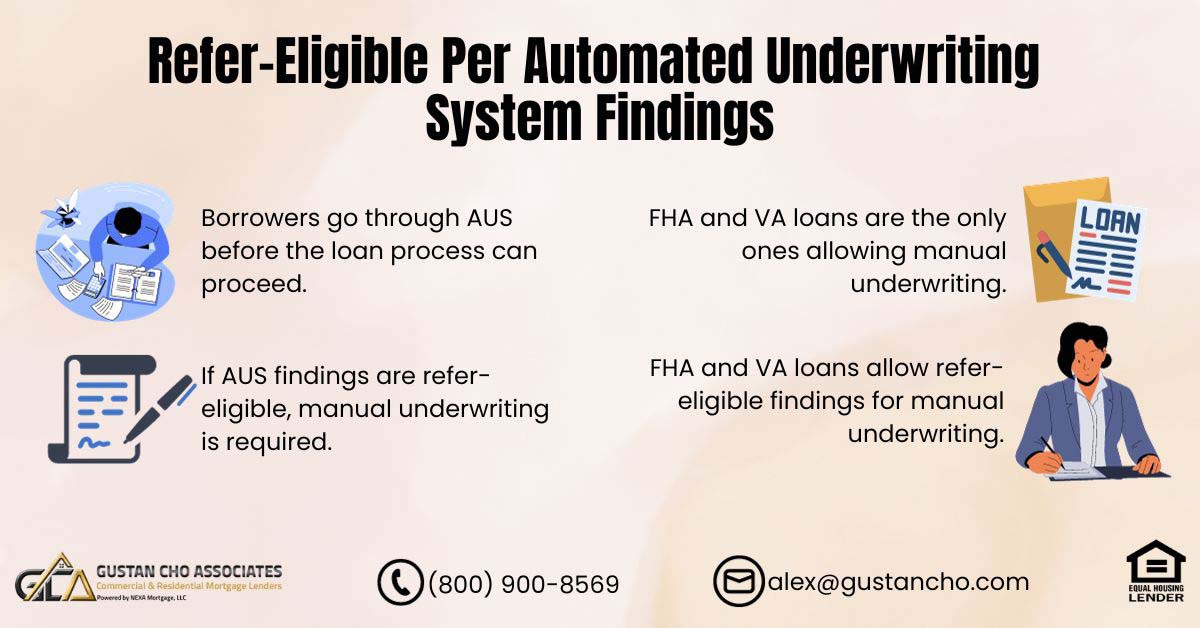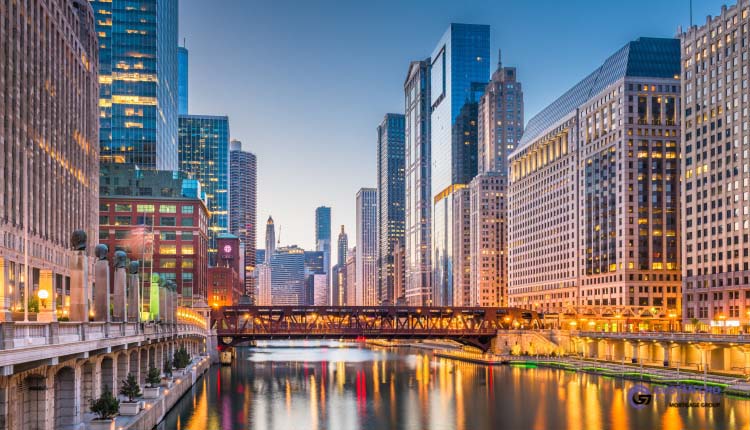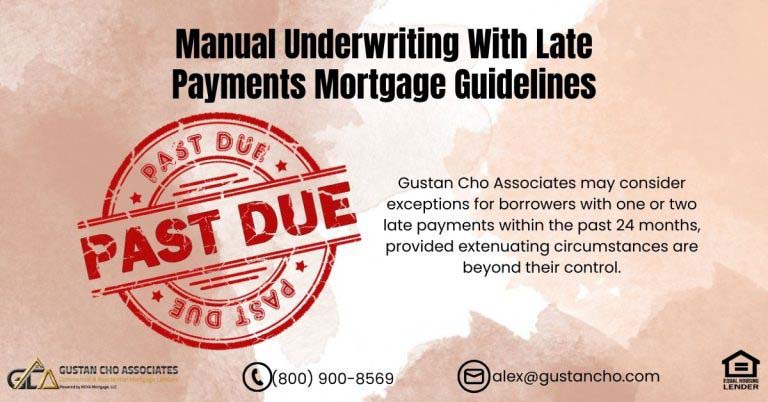This article will cover and discuss refer-eligible per automated underwriting system findings. All mortgage loan applicants need to go through the automated underwriting system (AUS) before the loan process can proceed. If the findings on the automated underwriting system render an approve/eligible, that means the AUS approves the borrower. There are three decisions the automated underwriting system will render:
The Three Automated Findings from AUS
The automated underwriting system (AUS) provides three main types of findings:
- Approve/Eligible per Automated Underwriting System: The file has received automated approval, meaning the application is in good standing and can proceed.
- Refer-Eligible per Automated Underwriting System: This finding means that while the automated system determines the mortgage loan applicant is eligible, it cannot issue an automated approval. As a result, the application requires manual underwriting for further assessment.
- Refer with Caution: This indicates that the automated underwriting system suggests against approval, meaning the borrower does not qualify for a mortgage.
It’s important to remember that only FHA and VA loans allow for manual underwriting. The following sections will explore how manual underwriting works in more detail.
Confused by Automated Findings from AUS?
Contact us today to understand what your AUS results mean and how they impact your mortgage approval.Understanding Refer-Eligible Per Automated Underwriting System
When you bake a cake using a recipe from a popular cooking app, the app checks your ingredients and steps. If everything looks good, it gives you a thumbs-up, which is like getting approval for your mortgage application from an automated system.
However, the app can’t thoroughly check if your oven works or if you have enough time to bake. It tells you to get a “kitchen expert” to take a closer look before you proceed. This is similar to getting a “refer-eligible” finding from the Automated Underwriting System.
You’re still on track but need a human expert (the manual underwriter) to review your cake recipe. This helps ensure your cake will turn out well.
When applying for a mortgage, the automated system may quickly approve your application, just like the cooking app gives you a thumbs-up for your cake. If there are any uncertainties—like if your oven is functioning or you have enough time—you may need a human expert to check things out before moving forward. This extra review helps ensure you have everything you need for success.
Lender Overlays on Refer-Eligible Per Automated Underwriting System Findings
Borrowers with outcomes flagged as refer-eligible by automated underwriting systems may have trouble getting approved by most banks or mortgage companies. Manual underwriting can be an option if a mortgage loan file is marked as refer-eligible. Not all lenders use manual underwriting, but it involves following specific guidelines. Underwriters look at compensating positive factors that can help the borrowers during manual underwriting.
Importance of Compensating Factors on Manual Underwriting.
Compensating factors are elements that can mitigate risk for lenders when evaluating a borrower’s mortgage application.
An example of a compensating factor is payment shock. Iff you’re moving from paying $800 in rent to a mortgage payment of $850, this small increase is viewed as less risky. Lenders appreciate that the jump is manageable, suggesting you can handle the new payment.
Another significant factor is a larger down payment. If you’re purchasing a $300,000 home and can provide a $60,000 down payment rather than just the minimum of $30,000, that additional equity indicates a stronger commitment. This suggests to lenders that you are less likely to default because you have more invested in the property from the beginning.
Having savings to cover several months of mortgage payments is very important. For example, if your monthly mortgage payment is $1,000, saving $3,000 shows you can handle payment changes better. This can also give lenders confidence in your financial stability.
In essence, these compensating factors help lenders feel more secure in lending you money by demonstrating that you are financially responsible and capable of handling your mortgage payments.
Refer-Eligible Per Automated Underwriting System: Reserves
Reserves refer to the amount needed to cover one month of your mortgage payment, which includes principal, interest, taxes, and insurance (PITI). Lenders typically prefer home buyers to have at least three months’ worth of reserves, which can strengthen your application.
Reserves don’t have to be in cash and can include assets such as:
- IRA accounts
- 401(k) accounts
- Securities accounts
- Other liquid investment accounts
When calculating reserves, lenders consider the liquidity of these assets. For example, if your monthly PITI is $2,000, you’ll need $6,000 in reserves.
If you have $3,000 in cash, $10,000 in a securities account, and $5,000 in an IRA, your total accessible reserves amount to $13,000, which exceeds the $6,000 requirement. This demonstrates to lenders that you have sufficient reserves and can manage your payments effectively.
Refer-Eligible Per Automated Underwriting System Versus Approve Eligible Per AUS
Borrowers can get the Automated Underwriting System (AUS) approval if they meet the minimum federal mortgage guidelines. In an FHA loan scenario, if a borrower receives a refer-eligible per automated underwriting system status, their application will require manual underwriting. In order to be eligible for a 3.5% down payment, borrowers must have a credit score of no less than 580. If a borrower’s credit score falls below 620, the maximum allowable debt-to-income ratio may be reduced to 43% because of potential risks flagged by the AUS.
Automated Findings Impacting Your Loan Approval?
Contact us today for a detailed explanation and to explore your options for approval.Gift Fund Guidelines on Refer-Eligible Per Automated Underwriting System Findings
Using gift funds for a down payment can make it harder to get approved for an FHA mortgage. Here’s why it might be better not to use it:
- Financial Stability: Relying on gifted funds may signal financial instability. Not using them shows a stronger financial position.
- Lower Risk: Gifted funds can complicate the application process. Removing them simplifies the review and lowers risk, leading to better AUS results.
- Credit Image: Without gifted funds, borrowers appear more financially independent, which can ease concerns about credit history or scores.
- Easier Approval: A simpler application helps AUS issue approve-eligible status instead of refer-eligible, which needs extra review.
In summary, not using gifted funds can streamline the approval process.
Is It Possible To Get a Refer-Eligible Per Automated Underwriting System Converted To an Approve Eligible?
Yes, the answer to this question is yes. This is a common practice. Experienced mortgage loan originators often check if they get a refer-eligible outcome from automated findings. They do this to adjust the details and achieve an approve-eligible result. The loan officer’s first step is to carefully review the automated findings. They identify the reasons for receiving a refer-eligible status instead of an approve-eligible one.
Automated Underwriting System Decides Conditions on Gift Funds and Other Risk Factors
In numerous instances, when dealing with mortgage applicants who only marginally satisfy the federally mandated mortgage lending criteria, automated findings often disfavor the use of gifted funds for the down payment when purchasing a home.
Simply eliminating the gift funds and utilizing the borrower’s funds has the potential to transform a refer-eligible status into an approve-eligible one.
Another scenario where a refer-eligible outcome can be converted to approve-eligible is incorporating additional assets into the borrower’s application. The automated system views reserves as significant compensating factors, especially when the borrower barely meets the obligatory minimum guidelines. Increasing the amount of assets can shift the finding from refer-eligible to approve-eligible.
FHA and VA Loans Allow Refer-Eligible Per Automated Underwriting System Findings For Manual Underwriting
Individuals in this category will receive a referral eligibility based on the Automated Underwriting System (AUS). Direct lenders, such as myself, proficient in manual underwriting, can process these files. It’s important to note that not all lenders are equipped to handle manual underwriting.
It is crucial to ensure that a mortgage lender can conduct manual underwriting, especially for individuals with a Chapter 13 Bankruptcy discharge.
In situations where the automated system findings are rigid and unyielding on referral eligibility, the only avenue to secure approval for a home loan through manual underwriting is to obtain a referral eligibility per the Automated Underwriting System, ensuring it is not marked as “refer/caution.”
How To Start The Pre-Approval Mortgage Process
Homebuyers must qualify for a mortgage company licensed in 48 states with over 160 wholesale lenders. We have a national reputation for having dozens of wholesale lending relationships with lenders with no overlays. If you have any questions about getting pre-approved and qualified for a mortgage, contact us at Gustan Cho Associates at 800-900-8569 or text us for a faster response. Or email us at alex@gustancho.com. We have no overlays on FHA, VA, USDA, and Conventional loans. We are also experts in non-QM and alternative lending programs. The team at Gustan Cho Associates is available 7 days a week, evenings, weekends, and holidays.
Get Your AUS Findings Explained
Contact us now to get a clear explanation and to find the best way forward.FAQs about Refer-Eligible Per Automated Underwriting System Findings
Q: What is an Automated Underwriting System (AUS)?
A: An Automated Underwriting System (AUS) is a computerized program used by mortgage lenders to assess a borrower’s creditworthiness and determine if they qualify for a mortgage loan.
Q: What are the Three Types of Findings from the AUS?
A: The AUS provides three types of findings:
- Approve/Eligible: This means the borrower has received automated approval and is ready to proceed with the loan process.
- Refer-Eligible: This indicates that while the borrower is eligible for a mortgage, the AUS cannot provide automated approval, and manual underwriting may be necessary.
- Refer with Caution: This finding suggests that the borrower does not qualify for a mortgage and has been denied.
Q: What Does “Refer-Eligible Per Automated Underwriting System” Mean? “
A: Refer-Eligible Per Automated Underwriting System” signifies that the AUS cannot provide approval based on automated findings. Borrowers with this outcome may qualify for manual underwriting.
Q: How do Lenders Handle Refer-Eligible Outcomes from the AUS?
A: Lenders may have overlays on refer-eligible outcomes, making it challenging for borrowers to obtain approval. Manual underwriting, where a mortgage underwriter assesses the application manually, becomes an alternative option.
Q: What are Compensating Factors in Manual Underwriting?
A: Compensating factors are positive elements that favor borrowers during manual underwriting. These may include larger down payments, payment shock considerations, and reserves, among others.
Q: How are Reserves Evaluated in Manual Underwriting?
A: Reserves are crucial in manual underwriting, typically equivalent to one month’s PITI (Principal, Interest, Taxes, and Insurance). Having at least three months of reserves, including assets like IRA or 401(k) accounts, strengthens the borrower’s application.
Q: Can a Refer-Eligible Outcome be Converted to Approve-Eligible?
A: Yes, it’s possible to convert a refer-eligible outcome to approve-eligible. Mortgage originators often review the reasons for the refer-eligible status and may adjust details such as using gifted funds or incorporating additional assets to meet the criteria.
Q: Which Loans Allow Refer-Eligible Outcomes for Manual Underwriting?
A: FHA and VA loans are among the few mortgage programs that permit refer-eligible outcomes for manual underwriting. Not all lenders are equipped to handle manual underwriting, so finding a lender experienced in this process is essential.
Q: How Can Borrowers Start the Pre-Approval Mortgage Process?
A: To begin the pre-approval mortgage process, borrowers can contact licensed mortgage companies like Gustan Cho Associates. They provide services in 48 states and offer various loan programs with no overlays, including FHA, VA, USDA, and conventional loans.
This blog about “Refer-Eligible Per Automated Underwriting System Findings” was updated on May 1st, 2025.











Need to refi to pay off outstanding tax debt, rehab and then sell. Home has been in family for 50yrs. Currently in Ch 13 BK Adversary. Need loan commitment in writing by 8/17/2021.